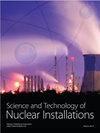Debris Bed Self-Leveling Mechanism and Characteristics for Core Disruptive Accident of Sodium-Cooled Fast Reactor: Review of Experimental and Modeling Investigations
IF 1
4区 工程技术
Q3 NUCLEAR SCIENCE & TECHNOLOGY
引用次数: 3
Abstract
Evaluations of the Core Disruptive Accident (CDA) are significantly important for safety analysis of Sodium-cooled Fast Reactor (SFR) despite the very low probability of occurrence for CDA. During the material-relocation phase in CDA of SFR, the molten materials are possibly released from the core region into subcooled sodium, subsequently forming the debris bed on the lower part of the reactor vessel after being quenched and fragmented. The accumulated high-temperature debris with decay heat can cause sodium coolant boiling, leading to the so-called “debris bed self-leveling behavior” during which the shape of the debris bed becomes flattered (leveling). It is important to investigate the debris bed self-leveling behavior due to its potential capacity to induce the transfer of debris and affect the ability of cooling and criticality of the debris bed. Thus, in recent years, valuable knowledge concerning the mechanism and characteristics of this behavior was accumulated through lots of experimental results and modeling developments. Aimed at providing a valuable guideline for future investigations on this issue, in this study, the past experimental and modeling investigations on debris bed self-leveling mechanism and characteristics are systematically summarized and reviewed, and some future remarks are also proposed to promote the progression of further research for SFR severe accident analysis.钠冷快堆堆芯破坏事故碎片床自流平机理与特性:实验与模型研究综述
堆芯破坏事故(CDA)的评估对于钠冷快堆(SFR)的安全分析非常重要,尽管发生CDA的概率非常低。在SFR的CDA中的材料重新定位阶段,熔融材料可能从堆芯区域释放到过冷钠中,随后在淬火和破碎后在反应堆容器的下部形成碎片床。积累的具有衰变热的高温碎片会导致钠冷却剂沸腾,导致所谓的“碎片床自流平行为”,在这种行为中,碎片床的形状变得平坦(平整)。研究岩屑床的自流平行为很重要,因为它可能会引起岩屑的转移,并影响岩屑床的冷却能力和临界性。因此,近年来,通过大量的实验结果和建模发展,积累了有关这种行为的机制和特征的宝贵知识。为了为今后的研究提供有价值的指导,本研究系统地总结和回顾了以往关于碎石床自流平机理和特性的实验和建模研究,并提出了一些未来的意见,以促进SFR严重事故分析的进一步研究进展。
本文章由计算机程序翻译,如有差异,请以英文原文为准。
求助全文
约1分钟内获得全文
求助全文
来源期刊

Science and Technology of Nuclear Installations
NUCLEAR SCIENCE & TECHNOLOGY-
CiteScore
2.30
自引率
9.10%
发文量
51
审稿时长
4-8 weeks
期刊介绍:
Science and Technology of Nuclear Installations is an international scientific journal that aims to make available knowledge on issues related to the nuclear industry and to promote development in the area of nuclear sciences and technologies. The endeavor associated with the establishment and the growth of the journal is expected to lend support to the renaissance of nuclear technology in the world and especially in those countries where nuclear programs have not yet been developed.
 求助内容:
求助内容: 应助结果提醒方式:
应助结果提醒方式:


